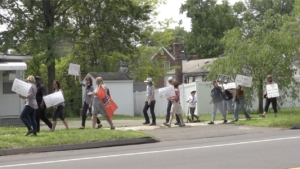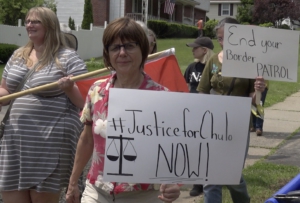A group of 20 activists and local citizens met and marched against police brutality on June 1 in Wethersfield, Connecticut. It was the third protest in the city since the killing of Anthony “Chulo” Jose Vega Cruz by a Wethersfield police officer on April 20.
Unlike the chants and confrontations of previous protests, which included a march to the home of Wethersfield Mayor Amy Morrin Bello, this one was silent. No chants, no noise, but no less powerful.
“We want this march to represent the voices of those who have been silenced,” Moral Mondays CT organizer Pamela Selders stated. “Starting with Chulo’s voice, who has been permanently silenced.”
Moral Mondays Connecticut was lead sponsor for the action, during which protesters marched down a 1.5-mile corridor along Jordan Lane. The roadway straddles the border between Wethersfield and the neighboring city of Hartford. Marchers held signs reading “Justice For Chulo,” “Black Lives Matter,” “End Profiling” and “End the Border Patrol.”

The term “Border Patrol” has become local slang for the police presence in this this particular area. “This is where my biennial pull-over by the Wethersfield police often occurs, and this have been going for 20 years,” March co-organizer Bishop John Selders told fellow activists. “I’ve been pulled over here a number of times for no reason.”
Wethersfield police have been cited in a recent study by the Racial Profiling Prohibition Project from Central Connecticut State University as among the leaders of Connecticut’s 169 towns and cities in the number of traffic stops of Black and Latino motorists. In 2015, according to the study, 47 percent of motorists stopped by police in Wethersfield are Black and Latino, yet the town population is 90 percent white. No other town in the state has such a ratio, nor the number of traffic stops, according to the study.
Wethersfield officials, especially police chief James Cetran, who has been at the center of great deal of controversy since the Cruz shooting for his perceived indifference over the incident, has consistently denied and derided the Project’s data.
Such is an example of tensions along this border between the town of 27,000 and the bordering largely Black and Brown areas of Hartford, the neighboring state capital of over 125,000. “I grew up in Charleston, South Carolina and I thought moving up north, things would be better here,” Wethersfield resident Lindsey Jones said. “This is the most segregated place I’ve ever lived in. There’s a ‘Build The Wall’ mentality here in regard to how Wethersfield sees Hartford.”

Jones, who is part of a group that organized in the wake of the Cruz shooting called Wethersfield Women for Progress, was among a group of local residents who have been actively organizing in the town, questioning civic leaders , and taking part in the recent string of demonstrations including this action.
One local resident, Farah Evenson, brought her young son out with her. “I’m teaching him to stand up for others and we all should be teaching our kids that,” she said. “My heart still shatters for Chulo’s family. It’s our job to stand up. How can I stop marching if the discrimination hasn’t stopped?”





